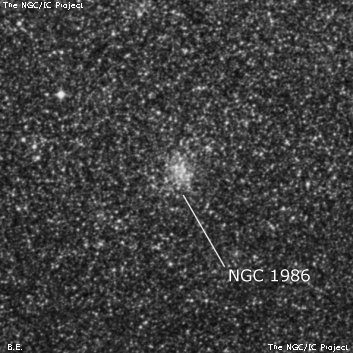
H-S 307, a very faint cluster, lies 4.8' NNE (logged as "small, round and grainy, ~25" diameter") and a very small trio of clusters, NGC 1969, 1971 and 1972 is ~9' NW. NGC 1959 is a bit further away at 11' WNW with NGC 1950 continuing on the same line 16.5' WNW. All of these clusters are visible in the same 30' field of the 13mm Ethos at 200x. In addition, a number of clusters, including H-S 327, S-L 519, S-L 535 and NGC 2016 are nearly on a line extending to the east!
John Herschel discovered NGC 1986 = h2883 on 24 Nov 1834 and recorded "pF; pL; R; glbM; 2'." His position (measured on 4 sweeps) is accurate. James Dunlop possibly discovered NGC 1986 = D 94? earlier on 27 Sep 1826 and simply logged "an extremely faint small nebula." His position is 7' due south of the cluster. Another possibility is D 96, recorded on 24 Sep 1826, refers to this cluster. He reported "a faint round nebula nebula, about 1 1/4' diameter, slightly bright to the centre." Dunlop's position here is further off - 12.6' ESE - but is the entry Glen Cozens identifies as NGC 1986.
600/800mm - 24" (4/7/08 - Magellan Observatory, Australia): at 260x, this LMC globular appeared very bright, fairly large, round, at least 2' diameter, with a bright core and several faint stars resolved. At 346x, at least a couple of dozen stars were resolved in the fainter halo and over the disc. There is a brighter elongated bar in the central portion (reminiscent of M4). Located 7.5' NE of a mag 8 star (HD 36598) near the southeast end of the LMC's central bar.
Notes by Steve Gottlieb